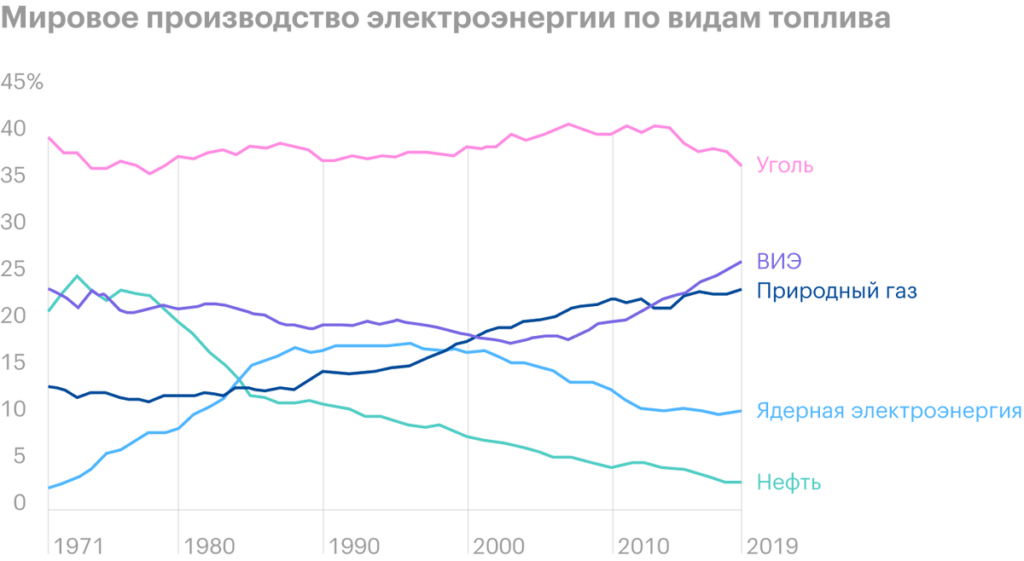
Fuel cells are used to store and generate energy from hydrogen. The first hydrogen fuel cell was designed by English scientist William Grove in the 30s. 19 century. Grove and Christian Schönbein, who worked in parallel with him, demonstrated the possibility of producing energy in a hydrogen-oxygen fuel cell using an acid electrolyte.
In 1959, Francis T. Bacon of Cambridge added an ion exchange membrane to the hydrogen fuel cell to facilitate the transport of hydroxide ions. Bacon's invention immediately became interested in the US government and NASA., the updated fuel cell began to be used on the Apollo spacecraft as the main source of energy during their flights.
Unlike oxygen, hydrogen is practically not found on earth in its pure form and is therefore extracted from other compounds using various chemical methods..
According to these methods, it is divided into color gradations.
Green – produced from renewable energy sources by electrolysis of water. Everything, what is needed for this: water, electrolyzer and large supply of electricity.
Blue – produced from natural gas, and harmful waste is captured for secondary use. Nevertheless, this method cannot be called perfectly pure..
Pink or red - Produced by atomic energy.
Grey – hydrogen is obtained by converting methane. During its production, harmful waste is emitted into the atmosphere.
Brown – hydrogen is obtained as a result of coal gasification. This method also leaves behind greenhouse gases..
There are also technologies for obtaining biohydrogen from garbage and ethanol, but their proportion is extremely small..
Cost of production by types of hydrogen, dollar per kilogram
| Green | 10 |
| Blue | 2 $ |
| Red | 2 $ |
| Grey | 2—2,5 $ |
| Brown | 2—2,5 $ |
10 $
Hydrogen energy
Coal processing accounts for 18% hydrogen production, 4% provided by green hydrogen and 78% - processing of natural gas and oil. Manufacturing methods, based on fossil fuels, generate 830 million tonnes of CO2 emissions each year, which is equal to emissions from the UK and Indonesia, combined. And yet hydrogen is a cleaner alternative to traditional fuels..
There are three main sources of emissions in the world, warming the climate: transport, power generation and industry. Hydrogen can be used in all three areas. When used in fuel cells, hydrogen energy leaves minimal losses, and after use as a by-product, only water remains, from which hydrogen can be extracted again.

Industry Outlook
According to the IEA report, by 2050, the global demand for hydrogen should reach 528 million tons - against 87 million in 2020, - and its share in world consumption will be 18%, of them 10% will account for green hydrogen.
By 2050, the IEA plans to reduce the cost of producing this clean fuel to 2 $ per kilogram, which is significantly lower than the current 10 $. This will happen due to the development of renewable energy technologies and the cheapening of wind and solar energy production..
In June 2020, Germany announced the implementation of a national hydrogen strategy with an investment of 7 billion euros, to become a leader in this field.
Japan, France, South Korea, Australia, Netherlands and Norway started their hydrogen course before Germany, and Japan did it before anyone else, in December 2017..
In July 2020, the Ministry of Energy prepared a plan for the development of hydrogen energy in the Russian Federation for the period 2020-2024. Rosatom is going to produce hydrogen, Gazprom and Novatek. The roadmap provides for the following measures::
- support of pilot projects for hydrogen production;
- incentives for exporters and buyers in the domestic market;
- the first hydrogen installations will be launched in 2024 at nuclear power plants, gas production and processing facilities.
In 2021, HydrogenOne Capital is the world's first investment fund, focused on green hydrogen, announced a listing on the London Stock Exchange. The fund invests in projects with a capacity of 20-100 MW with the possibility of expanding them up to 500 MW.
Benefits of hydrogen energy
High applicability. Electrification of transport will help reduce emissions into the atmosphere, but aviation, long-distance sea and freight transport is difficult to convert to the use of electricity, because these sectors require high-energy density fuels. Green hydrogen can meet these needs. For example, Airbus unveils hydrogen-powered aircraft concepts and hopes to put it into service by 2035.
Nikola builds semi-trailers, Working both on rechargeable batteries, and on hydrogen. The company declares, that its fuel cells can operate at lower temperatures, than batteries. And they're lighter., which makes them more practical for trucks and other heavy equipment. Nikola also states, that the range of such a truck would be 900 miles on a tank of hydrogen. For comparison: Tesla Semi battery-powered, which could go into production later this year or in 2022, declared range - 200-300 miles.
Also, Toyota presented their similar models of transport., Honda and BMW.
Fuel cell electric vehicle refueling time averages less than four minutes.. At the same time, unlike batteries, they do not need to be recharged.. Because they can operate independently of the network, then can be used as spare electricity or heat generators.
An important element of the transition to hydrogen is its use in housing and communal services. In addition to pilot projects in the UK, Leeds will become the first city, the power supply of which will be completely hydrogen. According to plan, all gas networks and transport equipment will be transferred to it.
Hydrogen reserves are virtually limitless. Since it is found almost everywhere, it can be used there, where it is produced. Unlike batteries, which cannot store large amounts of electricity for a long time, hydrogen can be produced from excess renewable energy and stored in large quantities.
Energy efficiency. Hydrogen contains almost three times more energy, than fossil fuels, therefore, it takes much less to do any work. For example, compared to a power plant, operating on fuel combustion with an efficiency of 33 to 35%, hydrogen fuel cells will perform the same function with efficiency up to 65%. For example, solar cells have efficiency — 20%, and in windmills — 40%.
In the spring of 2020, the world's largest power plant was launched in the city of Fukushima., hydrogen-powered. To power the electrolysis plants, solar batteries with a total power are placed on it. 20 Mw. In total, the station produces 1.2 thousand cubic meters of hydrogen per hour.
In automobiles, fuel cells use 40-60% of fuel energy, and also provide a reduction in its consumption by 50%.
Green hydrogen is a great medium for energy storage. For example, Germany has a problem with the power grid. On clear and windy days, solar screens and wind turbines in the north produce more electricity., what can this part of the country consume. Because of this, Germany is forced to sell surplus electricity to neighboring countries at a loss.. Excess electricity from renewable energy sources can be stored in the form of hydrogen, and then burn to generate electricity, when it is necessary.
Disadvantages of hydrogen energy
Green hydrogen cost. As mentioned above, it is the cost of producing the purest type of hydrogen that poses the strongest obstacles to its development.. According to the words and forecasts of the Ministry of Energy of the Russian Federation, prospects of hydrogen energy are associated with cheaper cost of hydrogen, produced by electrolysis of water. The main factors in ensuring the competitiveness of green hydrogen are the prospective reduction of capital costs for electrolyzers, as well as the cost of electricity from renewable energy sources.
When the production of electrolysers is scaled up, their cost may decrease from the current 1000 to 200 $/kW by 2050, rated J. P. Morgan - even before 100 $/kw. If this scenario is realized by 2050, the cost of electrolysers may decrease to less than 2 $/Kg. But taking into account the application of various state subsidy programs for hydrogen energy, these terms can be reduced..
Cost of green hydrogen production by country by 2050, euros for 1 Kg
| Argentina | 1,5 |
| Australia | 1,25 |
| Brazil | 1,25 |
| Canada | 1,5 |
| Chile | 1,25 |
| China | 1,25 |
| France | 2 |
| Germany | 2,25 |
| India | 1,25 |
| Japan | 2,75 |
| Morocco | 1,25 |
| Poland | 2,5 |
| Russia | 1,5 |
1,5
Flammability. Compared to gasoline, natural gas and propane hydrogen is more flammable in the air, the slightest cracks in the tank can lead to tragedy. But some critics are mistaken., when they say, that with the development of hydrogen energy, "the world will sit on a huge powder keg". Since hydrogen is very light - about 57 times easier, than gasoline vapors, – it can quickly dissipate in the atmosphere, and this is a positive factor for safety.
Storage and transportation. Since hydrogen is the lightest among the chemical elements, in a given volume it fits much less, than other fuels. For example, a much larger cylinder with hydrogen gas will be required, to drive a preset distance by car. The existing gas tanks are too small, to hold the amount of hydrogen, which is needed for the distance, which will cover a full gas tank. To solve this problem, methods of converting hydrogen into a liquid or gaseous state are now being modernized.. It must either be cooled to −253 °C, to liquefy, or compress to pressure, 700 times higher than atmospheric, so that it can be delivered as compressed gas.
Currently, hydrogen is transported through special pipelines, in tankers for low-temperature liquids, in tubular trailers, carrying hydrogen gas, by rail or barge.
In its turn, governments of countries are already "booking" future volumes of hydrogen raw materials, negotiating and signing relevant international agreements. Examples include the German-Moroccan Agreement on Cooperation in the Field of Green Hydrogen in June 2020., the Japan-Australia Joint Statement on Cooperation in the Field of Hydrogen and Fuel Cells in January 2020 and the Russian-German Declaration of Intent on Cooperation in the Field of Sustainable Energy.
Production
In hydrogen energy, a large selection of companies. The largest representatives are hydrogen producers, which basically use the cheapest method of production – steam reforming. Small companies focus exclusively on specific aspects of hydrogen use. They can mainly be divided into electrolyzer manufacturers and fuel cell manufacturers.. Some companies are working on, to become a fully vertically integrated hydrogen energy supplier. Let's analyze each category separately.
Hydrogen producers
Air Products. The main activity of Air Products is the production of atmospheric and technological gases and related equipment for various industries, including oil refining, petrochemicals and metallurgy.
The company in 2020 announced plans to build a plant for the production of environmentally friendly hydrogen in Saudi Arabia, powered by wind and solar power 4 GW, — now it is the world's largest project. The completed plant will produce 650 tons of green hydrogen daily, which is enough to operate about 20 thousand buses.
Linde is one of the world's largest companies, specializing in the field of industrial training technologies, separation and liquefaction of natural gas. In 2021, the company announced, that it signed a long-term agreement with Infineon Technologies for the production and storage of environmentally friendly hydrogen. Linde will build, own and operate a two-megawatt electrolysis plant in Austria. The plant will produce green hydrogen using proton exchange membrane technology (PEM) from ITM Power.
Cummins presented the hydrogen strategy in November 2020. In 2019, the company acquired Hydrogenics, as a result, received a technology for the production of fuel cells and electrolyzers.
All these are large companies with extensive experience in the field of industrial gas. Their main focus today is on gray hydrogen., but they are also moving to cleaner solutions. The shares of these companies are habitually growing with the market., and you can talk, that among the rest of the representatives they are reasonably priced.
Comparative indicators of companies, billion dollars
| Market capitalization | Revenue in 2020 year | P / E | P / S | |
|---|---|---|---|---|
| Air Products (APD) | 61,68 | 8,86 | 29,59 | 6,97 |
| Linde (LIN) | 132,41 | 27,05 | 52,72 | 4,69 |
| Cummins (CMI) | 36,49 | 19,56 | 21,59 | 1,88 |
Fuel Cell Companies
Ballard Power Systems specializes in the integration of fuel cells into buses and trucks. Ballard provides fuel cell systems for other companies, who integrate them into their cars.
Bloom Energy manufactures fuel cell servers, they represent stationary power systems, Mainly designed for backup power supply. The company also produces electrolyzers and presented a hydrogen strategy in July 2020..
FuelCell Energy works in the same sector, as Bloom Energy. Produces power plants based on stationary fuel cells.
Plug Power aims to become a major producer of environmentally friendly hydrogen. The company acquired enterprises for the production of its own electrolyzers and hydrogen filling stations. Plug Power Works with Clean Energy Producers Brookfield Renewable Partners (BEP) and Apex Clean Energy on the construction of hydrogen plants. The company is building a nationwide network of clean hydrogen.
PowerCell Sweden produces fuel cells mainly for transport systems. The company has a deal with Bosch. Bosch can manufacture and sell fuel cells based on PowerCell Sweden design.
Comparative indicators of companies, million dollars
| Market capitalization | Revenue in 2020 year | P / S | |
|---|---|---|---|
| Ballard Power Systems (BLDP) | 10 430 | 117,65 | 72,10 |
| Bloom Energy (BE) | 6400 | 758,40 | 6,44 |
| FuelCell Energy (FCEL) | 5820 | 70,87 | 56,53 |
| Plug Power (PLUG) | 28 760 | 307,54 | 66,94 |
| PowerCell Sweden (PCELF) | 2750 | 10,31 | 266,12 |
Companies — manufacturers of electrolyzers
We will not analyze each of the companies in detail, since all of them are still traded on the OVER-the-counter market. These companies are unprofitable, therefore, the coefficient P is not included here / E.
Comparative indicators of companies, million dollars
| Market capitalization | Revenue in 2020 year | P / S | |
|---|---|---|---|
| McPhy Energy (MPHYF) | 1170 | 13,96 | 55,49 |
| In the ASA | 5570 | 55,35 | 92,24 |
| ITM Power (ITMPF) | 450 | 6,31 | 594,46 |
Conclusion
In 2020, renewables have experienced an unusual boom in popularity.. This was facilitated by the year of the end of the reign of the Republicans in the United States., and attractiveness of ESG investments, as well as a soft credit policy. All this has created an economically attractive environment for many companies in this area..
Although there are many options for investing in the economics of environmentally friendly hydrogen, while entering the market is risky. These companies are still growing, and they need to reach a large scale, to make a profit in the future. Today, a good base for choosing is important for investing in hydrogen, activity-based, evaluations, partners and management.
